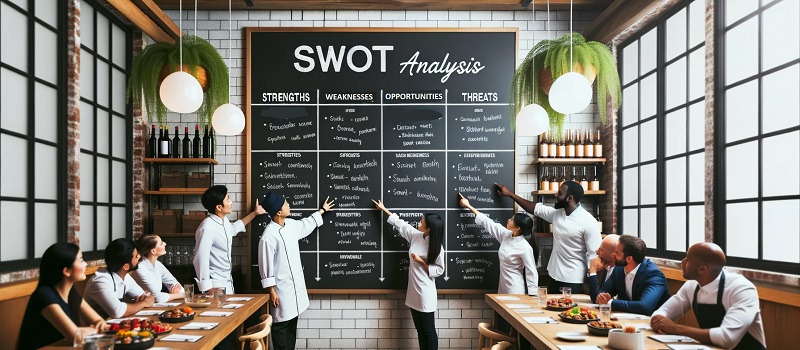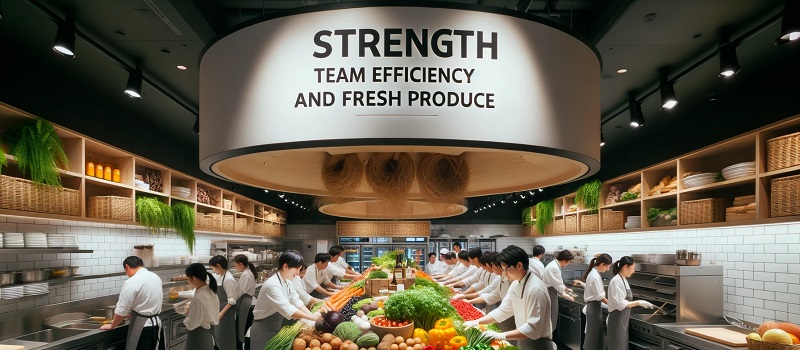🔥 Popular Free Downloads

THE FULL WORKS
All of our staff training manuals in one handy download!

FREE STAFF HANDBOOK
A totally customisable free staff handbook download.

FREE PROFIT & LOSS CALCULATOR
Keep on top of your expenses with our free profit and loss calculator.
🔥 Popular Pages
- How to Run a Restaurant
- Awesome Articles
- Managing Your Staff
- Marketing Your Restaurant
- Restaurant Financing and Funding
- Maintaining Neutrality in Pronoun Usage
- Everything You Wanted To Know About Gin
⭐ Popular Resources

SWOT ANALYSIS
SWOT Analysis explained in detail accompanied by a free download.

DOWNLOADS HUB
The place to download all of our free forms, templates & guides.

FREE CASH FLOW CALCULATOR
Download our free template or use our online cash flow calculator.

FREE MARKUP CALCULATOR
Maximise your profits with our free markup calculator tool.

BAR MANAGEMENT TRAINING
Simple and free online bar and cellar management training.

Understanding Restaurant SWOT Analysis - With Free Download
Written by The Restaurant Doctor
UK Team
Last Updated: 20th October 2023
Conducting a restaurant SWOT analysis is crucial for restaurant owners who aim to stay competitive and successful in today's dynamic food industry. A SWOT analysis is a component of marketing which helps to identify strengths, weaknesses, opportunities, and threats, which allows restaurant owners to improve their overall profitability by addressing weaknesses, leveraging strengths, and capitalising on new opportunities while mitigating risks.
What’s on this page:
- What is a Restaurant SWOT Analysis?
- Why Do You Need to Conduct a Restaurant SWOT Analysis?
- How to Conduct a Restaurant SWOT Analysis
- Restaurant SWOT Analysis Examples
- Case Study
- Tips for a Successful Restaurant SWOT Analysis
- Beyond the SWOT
- Free SWOT analysis download
What is a Restaurant SWOT Analysis?
A SWOT analysis is a powerful tool that helps businesses, including restaurants, evaluate their current situation and pinpoint areas for growth and improvement. The analysis is composed of four main components, which can be explained in more detail as follows:
Strengths

Strengths refer to the internal positive attributes of a restaurant that give it an advantage over its competitors. These can include factors such as:
- Skilled and experienced staff. A knowledgeable and talented team can contribute to excellent customer service, efficient operations, and high-quality food.
- Strong brand A recognisable and reputable brand can attract more customers and foster loyalty.
- Popular menu A well-curated menu that appeals to customers' tastes can drive repeat visits and positive word-of-mouth.
- Unique selling proposition (USP): A USP, such as a signature dish or a novel dining concept, can help differentiate the restaurant from its competitors.
Weaknesses

Weaknesses are the internal negative attributes that can hinder a restaurant's success. Some examples include:
1. High staff turnover: Frequent staff changes can lead to inconsistent service and increased training costs.
2. Outdated equipment: Old or inefficient equipment can slow down operations and affect food quality.
3. Poor location: A location with low visibility or accessibility can result in fewer customers and lower revenue.
Opportunities

Opportunities are external factors that can be leveraged to benefit the restaurant. These can include:
1. Growing market: A rise in demand for a specific cuisine or dining experience can create new opportunities for expansion or menu updates.
2. New food trends: Adapting to emerging food trends, such as plant-based diets or sustainability, can attract new customers and keep the restaurant relevant.
3. Nearby developments: Proximity to new residential or commercial developments can lead to an increased customer base.
Threats

Threats are external factors that can negatively impact the restaurant's performance. Examples include:
1. Increased competition: The entrance of new competitors or the growth of existing ones can lead to a decrease in market share and revenue.
2. Changing regulations: New regulations, such as health and safety guidelines or zoning restrictions, can create additional compliance costs or operational challenges.
3. Economic downturns: Economic recessions or reduced consumer spending can result in lower revenue and decreased profitability.
By examining these four components, restaurant owners can develop a comprehensive understanding of their business's internal and external environment. This information can then be used to create strategic plans that address weaknesses, leverage strengths, and take advantage of opportunities while mitigating threats.
Why Do You Need to Conduct a Restaurant SWOT Analysis?
A SWOT analysis is a valuable tool for restaurant owners in several ways. Here is a more detailed explanation of the benefits mentioned earlier:
Identify areas of improvement and capitalise on strengths
By examining the strengths and weaknesses within the restaurant, owners can pinpoint areas that need improvement and find ways to capitalise on their strengths. For example, if a restaurant has excellent customer service as a strength, it can focus on maintaining and enhancing this aspect to create a loyal customer base. On the other hand, if the restaurant has a weakness in its menu options, it can work on expanding or improving the menu to attract more customers.
Anticipate changes in the market and adapt accordingly
A SWOT analysis involves examining external opportunities and threats, which helps restaurant owners stay informed about market trends and adapt to any changes. For example, if a restaurant identifies an increasing demand for plant-based food options as an opportunity, it can adapt by introducing more vegetarian or vegan dishes to its menu.
Make informed decisions about investments and resource allocation
By understanding the restaurant's strengths, weaknesses, opportunities, and threats, owners can make better decisions about where to invest their resources. For instance, if a restaurant identifies outdated kitchen equipment as a weakness, investing in modern equipment can improve efficiency and reduce operating costs. Similarly, if a restaurant recognises an opportunity in expanding its online presence, allocating resources to digital marketing can help attract more customers.
Enhance the restaurant's competitive edge
A SWOT analysis helps restaurant owners identify unique selling points and develop strategies to stand out from their competitors. For example, a restaurant might focus on offering exceptional customer service, unique menu items, or an innovative dining experience. By leveraging their strengths and addressing weaknesses, restaurants can create a competitive advantage in the market.
For example, a restaurant with a strong social media presence as a strength illustrates the importance of leveraging strengths for increased profitability. A restaurant with a robust social media following can use this advantage to create targeted marketing campaigns that reach a larger audience. By promoting special offers, events, or showcasing their menu items, the restaurant can attract new customers and maintain the interest of existing patrons, ultimately improving its overall profitability.

How to Conduct a Restaurant SWOT Analysis
1. Define your restaurant's objectives and goals
Start by establishing the objectives and goals you want to achieve with your restaurant, such as increasing revenue, expanding the customer base, or improving customer satisfaction. Having clear objectives will guide your SWOT analysis and ensure you focus on the most relevant aspects.
2. Gather data on your restaurant's internal and external environment
Collect information about your restaurant's internal operations, including staff performance, menu options, customer feedback, and financial data. This information will help you identify your restaurant's strengths and weaknesses. Additionally, research the external environment by examining market trends, competitor analysis, customer demographics, and any legal or regulatory factors affecting the industry. This will help you identify potential opportunities and threats.
3. List your strengths, weaknesses, opportunities, and threats
Based on the gathered data, create a list of your restaurant's strengths, weaknesses, opportunities, and threats. Be objective and honest in your assessment to ensure the analysis is accurate and useful.
4. Analyse the relationships between each component
Examine the relationships between the strengths, weaknesses, opportunities, and threats you've listed. For example, determine how your restaurant's strengths can be used to exploit opportunities or mitigate threats, and how weaknesses might hinder your ability to capitalise on opportunities or make you more vulnerable to threats. This analysis will help you prioritise and develop effective strategies.
5. Develop strategies to address each element
Create strategies to address each aspect of your SWOT analysis. For strengths, develop ways to leverage them further. For weaknesses, identify ways to improve or eliminate them. Exploit opportunities by aligning your restaurant's strengths with market trends or consumer preferences. Finally, develop strategies to mitigate or minimise the impact of threats on your restaurant's performance.
6. Implement, monitor, and adjust strategies as needed
Put your strategies into action and monitor their effectiveness. Keep track of your restaurant's performance through key performance indicators (KPIs) such as sales, customer satisfaction, or staff productivity. Regularly review the progress and results of your strategies, adjusting them as needed to respond to any changes in the internal or external environment. This iterative process will help you continuously improve and adapt to the dynamic nature of the restaurant industry.
Restaurant SWOT Analysis Examples
Fast Food Restaurant:
Strengths: Affordable menu, fast service, convenient location
Weaknesses: High employee turnover, unhealthy menu options
Opportunities: Introducing healthier menu items, expanding delivery service
Threats: Health-conscious consumers, increasing competition
Fine Dining Restaurant:
Strengths: Exceptional cuisine, skilled staff, unique ambiance
Weaknesses: High prices, limited seating capacity
Opportunities: Special event hosting, implementing a prix fixe menu
Threats: Economic downturn, shifting consumer preferences
Casual Dining Restaurant:
Strengths: Diverse menu, family-friendly atmosphere, reasonable prices
Weaknesses: Inconsistent service, outdated décor
Opportunities: Online ordering, loyalty programme
Threats: Growing competition, rising food costs
👉 For a full SWOT analysis for a fish & chip shop click here.
Case Study
Last year, “Joe's Diner” conducted a SWOT analysis and discovered that one of their significant weaknesses was a lack of online presence. Upon realising this, they invested in a new website and started social media campaigns. As a result, they saw a 20% increase in customer engagement online, leading to a 15% boost in reservations.
Tips for a Successful Restaurant SWOT Analysis
1. Be honest and objective when identifying strengths and weaknesses
When conducting a SWOT analysis, it's essential to be objective and honest about your restaurant's strengths and weaknesses. Avoid the temptation to overstate your strengths or downplay your weaknesses, as this can lead to an inaccurate analysis and ineffective strategies. Instead, strive for a balanced and truthful assessment, which will provide a solid foundation for making improvements.
2. Continuously monitor changes in the market and industry trends
The restaurant industry is dynamic and subject to constant change due to shifting consumer preferences, new technologies, and emerging competitors. To ensure your SWOT analysis remains relevant and useful, regularly monitor market trends and industry developments. Staying informed about these changes will help you identify new opportunities and potential threats early, enabling you to adapt your strategies accordingly.
3. Involve your team for diverse perspectives
Your restaurant's staff can provide valuable insights and perspectives on the business's strengths, weaknesses, opportunities, and threats. Involve them in the SWOT analysis process by soliciting their feedback and incorporating their input. This collaborative approach can help you identify areas for improvement that you may have overlooked and can lead to more effective strategies.
4. Regularly update your SWOT analysis to stay current
A SWOT analysis is not a one-time exercise; it should be regularly updated to reflect the current state of your restaurant and the market. As your restaurant evolves and the industry changes, your strengths, weaknesses, opportunities, and threats may also shift. By updating your SWOT analysis, you can ensure that your strategies remain relevant and effective in addressing the current challenges and opportunities.
5. Use the analysis to inform your restaurant's overall strategic plan
The SWOT analysis should not be an isolated exercise but rather an integral part of your restaurant's strategic planning process. Use the insights gained from your SWOT analysis to inform your overall strategic plan, which may include marketing strategies, menu development, staff training, or operational improvements. By integrating the SWOT analysis into your broader strategic planning, you can ensure that your restaurant is well-positioned to capitalise on its strengths, address its weaknesses, and respond effectively to changes in the market.
6. Feedback Loop
After implementing the strategies based on the SWOT analysis, actively seek feedback from customers, staff, and stakeholders. This will help you gauge the effectiveness of the implemented strategies and make necessary adjustments.
A thorough SWOT analysis is vital for restaurants to improve profitability and maintain a competitive edge in the industry. By identifying and addressing strengths, weaknesses, opportunities, and threats, restaurant owners can make informed decisions and implement effective strategies to ensure their establishment's long-term success.
Beyond the SWOT
Understanding larger macro-environmental factors through a PESTLE analysis can further enhance your restaurant's strategic planning. For instance, understanding technological trends might help a restaurant identify online delivery as an emerging trend, while legal insights might inform about new licensing or health regulations.
Free SWOT analysis download
To download your free restaurant SWOT Analysis, click on the download link below:
👉 YOUR DOWNLOAD
You may also like...
Business Finance, Credit, Borrowing Money and Funding:
Looking to borrow money or wanting to apply for a credit card, mortgage, overdraft, business loan or even car insurance for your restaurant? This article covers the areas you need to consider when applying for finance, borrowing money and applying for credit for your business. Looking after your money is important, especially money you borrow.